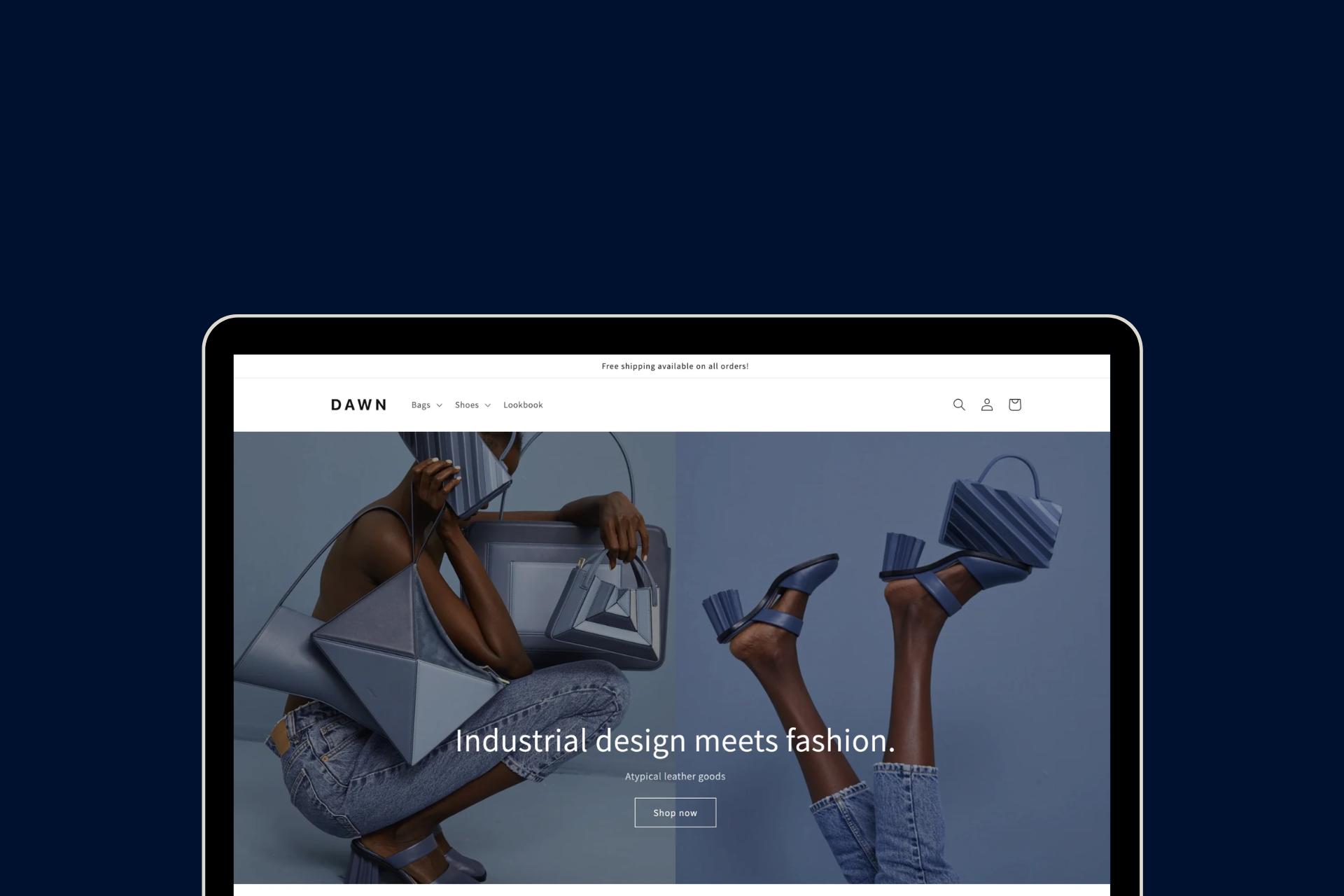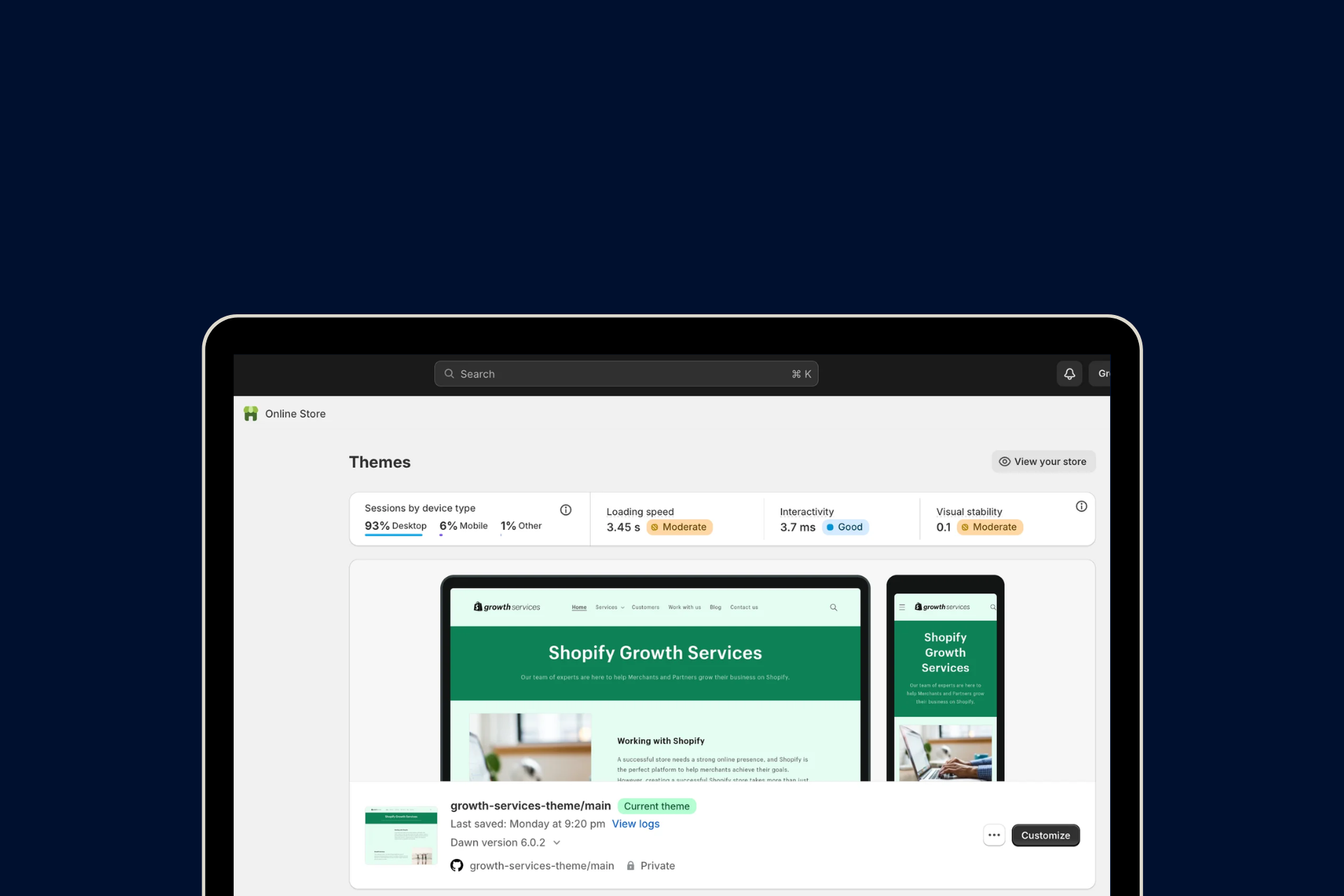You've probably heard the terms headless commerce, headless eCommerce, and single-page commerce. But what do they mean exactly? How are they any different? How can you tell if your business should use them? And if you decide to...how do you go about it?
Headless eCommerce has been the talk of the town for the customizations and the flexibility it has to offer. But so far it has been all about complexities and high dependencies on developers and developer dependencies on tools.
Shopify intends on changing that with the introduction of Shopify Hydrogen and Oxygen. The idea is that we should be able to sell a product without having to build a website for it. This would allow us to focus on selling products and not have to deal with the technicalities of building a website.
We will discuss the Shopify headless commerce framework, how to deploy a hydrogen storefront, and much more in this guide.
What is headless eCommerce?
Headless eCommerce is a model that separates the logic of your business from the frontend design and user experience. This means that you are able to control your store in a completely different way than before. This is a new way to manage your website and keep it running smoothly without having to worry about the back end.
The traditional approach to eCommerce is all about the product, with each product having its own page on your website.
Headless eCommerce turns this model on its head. Instead of focusing on individual products, it puts the user at its center. The goal is to make it as easy as possible for visitors to find what they want and buy it in as few steps as possible.
The idea behind this approach is to decouple the two layers and make it easier for companies to scale their business. This allows frontend and backend to be built and managed separately, which means that developers have more flexibility in building custom experiences for customers. The front-end can be used for any number of purposes, even if they are unrelated to selling products online.
For example, you could use your headless eCommerce platform to build an internal CRM system or a chatbot without affecting its performance when selling products on your website.
A headless commerce platform allows you to build your own custom store with a variety of options and features. These include -
- A customizable look and feel based on your brand's design preferences
- Fast page load times due to a lack of heavy JavaScript files
- A seamless checkout experience without any page redirects or popups
Headless commerce is important because it allows businesses to focus more on customer service while also cutting down on costs associated with running eCommerce websites and apps (such as web hosting fees). This will enable businesses to focus more resources on improving their customer experience while still making money off each sale made through their website or app.
Common challenges of headless eCommerce
Headless eCommerce allows merchants to focus on selling products and not have to deal with the technicalities of building a website. But what does this mean for you and your business? Here are some common challenges of headless commerce -
1. Expensive to implement
The first and most obvious challenge of headless commerce is cost — it costs money to build out the necessary infrastructure and integrations with third-party providers. Headless eCommerce requires dedicated engineers who can build out all these integrations, which can take time (and money).
If you want to implement headless commerce on your site, you need to build out integration points between your store and each payment processor you want to use — which means more engineering resources are required for each store you build out this way (and potentially more bugs).
2. Implementation and subsequent scaling requirements will increase
Implementing a headless eCommerce solution is not for the faint of heart. It requires significant time, resources, and expertise. If you’re not careful, you might end up spending weeks or months on the project without any results to show for it. But once you get started, things will start moving faster — more so if you have previous experience with similar projects or if you outsource development to a qualified agency that knows what they’re doing.
Companies with existing eCommerce websites will have to work closely with their development teams to migrate content from their legacy systems into their new headless commerce platform. This can take several months, which may not align with the timelines expected by business leaders who have already seen success with this model elsewhere.
3. Employees might take longer to adapt
Headless commerce allows retailers to focus on their customers' needs rather than focusing on internal operations like order management systems or inventory management systems. However, some employees might take longer to adapt to this change because they have been used to working with the traditional systems for years. There will be a learning curve and a steep cost for training employees on these new technologies and skillsets.
In fact, they might even think that they have too much work on their plate right now because there's no sign of anyone taking care of the website anymore.
4. It may be difficult to integrate third-party services
If you want to integrate third-party services like Google Analytics into your headless commerce platform, it will be harder than usual because these services expect you to have an actual website that they can integrate with their platforms.
What is Shopify Hydrogen?
Shopify Hydrogen is a lightweight, headless commerce platform that lets you build fast, responsive storefronts with a React-based front-end framework. It provides a quick start, build-start environment so you can focus on building unique commerce experiences. With Hydrogen, it's possible to build more personal and engaging shopping experiences without sacrificing speed or performance.
From pre-built components and starter templates to hooks and utilities that map directly to Shopify’s APIs, Hydrogen gives you the tooling you need to accelerate development.
What is Shopify Oxygen?
Shopify Oxygen is the latest technology offering from Shopify. It's the first of its kind, and it's changing the way merchants sell on Shopify. Once you’re ready to launch, deploy your Hydrogen site directly to the edge with Oxygen, Shopify’s global hosting solution that’s just a simple `git push` away.
How does Hydrogen work?
The basic idea of hydrogen is that it’s a framework for building headless commerce applications. Headless commerce is where the product catalog is separate from the storefront — it’s accessible via an API instead of through a website front end..
Hydrogen framework
Hydrogen offers fast server-side rendering provided by the Vite plugin. Vite-powered build tools enable rapid feedback loops. Changes are reflected immediately upon saving.
Here, only the minimum amount of the javascript is delivered to the browser and thus pushing for no more data matching waterfalls. This means customers don't need to wait for all of the requests to be resolved on the server before interacting with the page.
Vite's evergreen and modern philosophy aligns perfectly with Hydrogen. Featuring a lightning-fast development server with hot module replacement, a rich plugin ecosystem, & clever default configurations that make it work out of the box for most apps 👉 https://t.co/F8kNu83Ntp pic.twitter.com/7NZJT9RVLP
— Shopify Engineering (@ShopifyEng) May 9, 2022
Hydrogen components, hooks, and utilities
Hydrogen chips with Shopify-specific components and hooks for commerce to be accessible, performable, and ready to use. They also help to reduce the initial complexity and boilerplate needed for building a custom storefront.

Where does Oxygen come in?
Oxygen aids in hosting hydrogen apps with performance optimized for a global scale. You can also choose to deploy it to your favorite Node.js or worker platform. Since Oxygen is specifically built for Shopify Hydrogen, it obviously offers a much better hosting experience.
You can create a Hydrogen app from within the Shopify admin using the new Hydrogen channel. This creates a GitHub repository with storefront credentials already configured and kicks off the first deployment to Oxygen.
For Oxygen uses, every new push to the default branch will trigger a production deployment. To create a preview deploy, simply push to another branch. These deployments can be managed within the Hydrogen channel, including privacy settings and configuring environment variables.
Benefits of using Hydrogen
Easy setup
Hydrogen provides a default demo store template which makes building headless eCommerce stores a very easy task. Both JavaSript and TypeSciprt templates for the same are provided.

Faster development
As headless commerce uses APIs instead of HTML pages, developers don’t have to wait for page refreshes or code changes before seeing their work come to life in the browser. This means they can create applications much faster than traditional solutions like WordPress or Magento.
Performance Optimization
A fast website is good for the user experience, but it's also good for business. The faster your site loads, the more likely it is that users will make a purchase. Headless Commerce allows you to optimize your front-end performance by eliminating unnecessary code and reducing page weight.
Greater flexibility
Because applications are built on top of industry-standard APIs, headless commerce platforms are highly customizable and easy to integrate with existing business processes. They also allow for rapid iteration as we don’t have to wait for testable builds before making changes; we can simply make changes in real-time without having to rebuild our application each time we want to try something out!
What is a headless checkout?
Here, the checkout and payment processes are completely separated from the online store’s primary backend.
This lets buyers purchase items from a lot of channels - including emails, articles, social posts, event QR codes, etc. - and not just the website. In a nutshell, with headless checkout, online shoppers can complete a transaction without having to go to your Shopify website at all.
For instance, let’s say John is at an event. He notices the QR code of your store that is having a flash sale on his favorite product. He is excited and ready to buy. Without headless checkout, it might go like this:
- He scans the QR code.
- The link opens his default browser, landing on your online store website.
- John has to find the product that is on sale and then add it to her cart.
- Then he has to fill in the checkout form with details including name, credit card, billing address, etc.
Headless checkout can make this whole process so much simpler. Let’s take a look?
- John scans the QR code
- The QR itself has a buy option with one-click checkout.
- John completes the purchase in seconds.
- Your product is on the way to John.
Benefits of headless Checkout
Headless checkout allows online retailers to offer a robust buying experience across channels. It can help reduce friction when completing any online transaction. Some of its other benefits include:
- Extensive customization
- Increased number of checkout touchpoints
- Unique data and insights
What is Checkout Extensibility?
Shopify knows that businesses need new ways to check out to stay competitive, but they might not have the tech skills or want to spend money on it. That's why they made Shopify Checkout Extensibility.
Shopify Checkout Extensibility is a bunch of powerful features on Shopify that help you change how your checkout works. It's like a special checkout that's easy to upgrade and works super fast. It also connects smoothly with Shop Pay, a fast checkout option that helps customers buy your stuff quicker.
You can use Checkout Extensibility to customize your checkout without needing to know how to code. Or if you know tech stuff, you can use Shopify's tools to make a custom checkout.
And if you want to sell in other places besides your online store, Shopify has a "Buy Now" button. You can quickly put it in a blog post, email, or wherever else you want to sell. Just copy and paste a bit of code, and your customers can buy faster and easier. Read more about it here.
Shopify offers a strong platform that big stores can use for a checkout that can be changed to fit their needs. Some platforms have trouble handling a lot of shoppers, especially during big sales like Black Friday and Cyber Monday. If your checkout doesn't work well on those days and slows down or stops, you could lose money you would've made.
What is a headless checkout?
Here, the checkout and payment processes are completely separated from the online store’s primary backend.
This lets buyers purchase items from a lot of channels - including emails, articles, social posts, event QR codes, etc. - and not just the website. In a nutshell, with headless checkout, online shoppers can complete a transaction without having to go to your Shopify website at all.
For instance, let’s say John is at an event. He notices the QR code of your store that is having a flash sale on his favorite product. He is excited and ready to buy. Without headless checkout, it might go like this:
- He scans the QR code.
- The link opens his default browser, landing on your online store website.
- John has to find the product that is on sale and then add it to her cart.
- Then he has to fill in the checkout form with details including name, credit card, billing address, etc.
Headless checkout can make this whole process so much simpler. Let’s take a look?
- John scans the QR code
- The QR itself has a buy option with one-click checkout.
- John completes the purchase in seconds.
- Your product is on the way to John.
Benefits of headless Checkout
Headless checkout allows online retailers to offer a robust buying experience across channels. It can help reduce friction when completing any online transaction. Some of its other benefits include:
- Extensive customization
- Increased number of checkout touchpoints
- Unique data and insights
What is Checkout Extensibility?
Shopify knows that businesses need new ways to check out to stay competitive, but they might not have the tech skills or want to spend money on it. That's why they made Shopify Checkout Extensibility.
Shopify Checkout Extensibility is a bunch of powerful features on Shopify that help you change how your checkout works. It's like a special checkout that's easy to upgrade and works super fast. It also connects smoothly with Shop Pay, a fast checkout option that helps customers buy your stuff quicker.
You can use Checkout Extensibility to customize your checkout without needing to know how to code. Or if you know tech stuff, you can use Shopify's tools to make a custom checkout.
And if you want to sell in other places besides your online store, Shopify has a "Buy Now" button. You can quickly put it in a blog post, email, or wherever else you want to sell. Just copy and paste a bit of code, and your customers can buy faster and easier. Read more about it here.
Shopify offers a strong platform that big stores can use for a checkout that can be changed to fit their needs. Some platforms have trouble handling a lot of shoppers, especially during big sales like Black Friday and Cyber Monday. If your checkout doesn't work well on those days and slows down or stops, you could lose money you would've made.
Wrapping up
As Shopify moves further into the eCommerce market with the launch of their new headless platform, we can watch as other brands follow suit. Stores like Allbirds and Kamp Grizzly have already achieved great successes using the new Shopify headless stack.
When all the pieces are finally put together, Shopify can then claim to have truly revolutionized eCommerce as we know it. Of all the tools Shopify has created throughout its history, this is probably the most innovative one yet. If you haven't started to prepare your store yet, you better do so now!
You can reach out to us to help you get started with Shopify Hydrogen.
We help you bring your ideas to life with Shopify web design, development, marketing, and support services from experts. Our team of Shopify experts works with Shopify merchants like you to design the store that reflects the personality of your brand and caters to the functionalities you require.
Whether you want to revamp your existing design or build a new one from scratch, we will help you create a positive shopping experience on your Shopify store design.
Reach out to us at info@xgentech.net and we’ll help you build an effective Shopify store!




